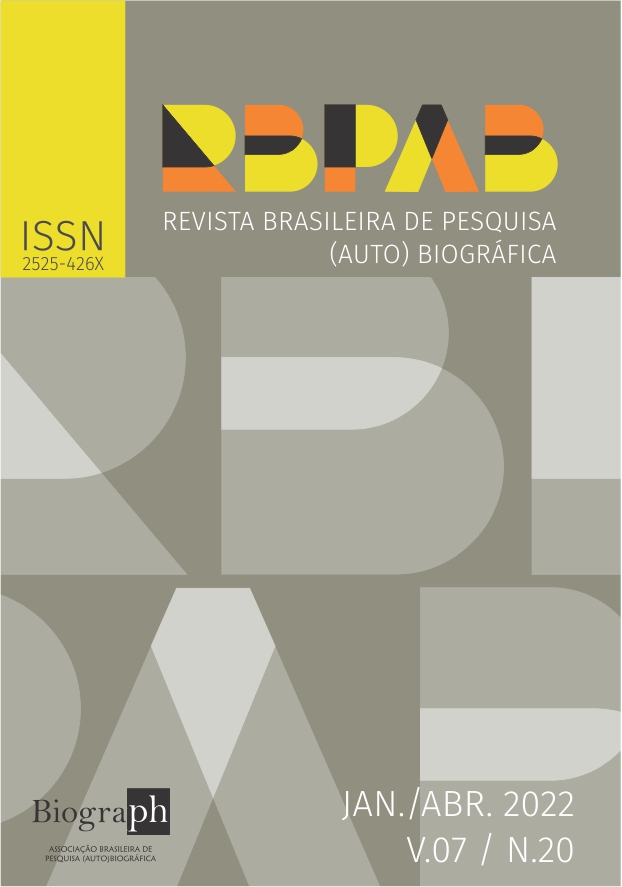Representações do passado escolar por mulheres autistas sob a abordagem (auto)biográfica
DOI:
https://doi.org/10.31892/rbpab2525-426X.22.v7.n20.p207-221Keywords:
Autismo, Autismo feminino, Narrativas de vida, Representações sociais, EscolaAbstract
This paper aims to investigate social representations about “being normal” regarding the school pasts of women diagnosed with level 1 Autism Spectrum Disorder. Emphasizing the (auto)biographical approach and using Social Representation Theory, the analysis allows an attentive listening of the subject’s individual stories, without ignoring the social aspects. This work presents some of the theories explaining the prevalence of “male” patients in ASD diagnosis, pointing to the hypothesis of “female” patients exhibiting different signs, which results in underdiagnosis. The interviews were semi-structured, with elements of a conversation interview. Among the eight life narratives, three will be presented in this work. The results show a sense of “being normal” connected to acting as their “colleagues”, even though there are some moments of bifurcation with “being normal” to teachers, possibly as a sign of school “normalization”. Despite the advancements being made, there is a lack of studies observing genders (which isn’t the same as biological sex) besides the “male” and “female” binary on the field. Therefore, this study reinforces the need for more research that allows subjects with disabilities to be listened to, for a more inclusive society.
Downloads
References
uma proposta de articulação. Revista de Educação Pública, v. 24, n. 55, p. 81-101, jan./abr.
2015. Disponível em: http://periodicoscientificos.ufmt.br/ojs/index.php/educacaopublica/article/view/2089/pdf.
Acessado em 20/09/2019.
ALVES-MAZZOTTI, Alda Judith; CAMPOS, Pedro Humberto. Cibercultura: uma nova “era das representações sociais”?. In ALMEIDA, Angela Maria de Oliveira; SANTOS, Maria de Fátima de Souza; TRINDADE, Zeidi Araujo (Orgs.). Teoria das Representações Sociais: 50 anos. Brasília: Technopolitik, 2014, p. 606-649.
AMERICAN PSYCHIATRIC ASSOCIATION. DSM-5: Manual Diagnóstico e Estatístico de Transtornos Mentais. Porto Alegre: Artmed, 2014
ANTUNES, Débora; DHOEST, Alexander. We are people and so are they: Shared intimacies and the ethics of digital ethnography in autism communities. Research Ethics, v. 15, n. 2, p. 1-17, 2019. Disponível em: https://journals.sagepub.com/doi/full/10.1177/1747016118820498. Acessado em 04 de fevereiro de 2020.
BARGIELA, Sarah; STEWARD, Robyn; MANDY, William. The Experiences of Late-diagnosed Women with Autism Spectrum Conditions: An Investigation of the Female Autism Phenotype. J Autism Dev Disord, vol. 46, 2016, p. 3281–3294. Disponível em: https://link.springer.com/content/pdf/10.1007%2Fs10803-016-2872-8.pdf. Acessado em
22/08/2018.
BECK, Jonathan et. alli. Looking good but feeling bad: “Camouflaging” behaviors and mental health in women with autistic traits. Autism, v. 24, n. 4, p. 809-821, 2020. Disponível em: https://journals.sagepub.com/doi/abs/10.1177/1362361320912147?journalCode=auta. Acessado em 04 de agosto de 2020.
BENFORD, Penny. The use of Internet-based communication by people with autism. 2008. 372 f. Tese (Doutorado em Filosofia) Universidade de Nottingham, Nottingham, 2008. Disponível em: http://eprints.nottingham.ac.uk/10661/1/thesis_post_viva_version_2.pdf. Acessado em 04 de agosto de 2020.
BRAGANÇA, Inês Ferreira de Souza. Histórias de vida e formação de professores: diálogos entre Brasil e Portugal. Rio de Janeiro: EdUERJ, 2012.
CASTRO, Monica Rabello de; FERREIRA, Giselle; GONZALEZ, Wania. Metodologia da pesquisa em Educação. Nova Iguaçu: Marsupial, 2013.
FELDMAN, Clara. Relatos sobre autismo: um estudo sobre narrativas em primeira pessoa. 2013. 96 f. Dissertação (Mestrado em Saúde Coletiva). Instituto de Medicina Social, Universidade do Estado do Rio de Janeiro, Rio de Janeiro, 2013. Disponível em: http://www.bdtd.uerj.br/tde_busca/arquivo.php?codArquivo=6315. Acessado em 24/01/2020.
FOUCAULT, Michel. Surveiller et punir: naissance de la prison. Paris: Gallimard, 1975.
FOUCAULT, Michel. Vigiar e punir: nascimento da prisão. 20ª Ed. Petrópolis: Vozes, 1999.
GREENBERG, David et. alli. Testing the Empathizing–Systemizing theory of sex differences and the Extreme Male Brain theory of autism in half a million people. PNAS, vol. 115, n. 48, Nov. 2018. Disponível em:
https://www.ncbi.nlm.nih.gov/pmc/articles/PMC6275492/pdf/pnas.201811032.pdf. Acessado em 09/04/2019.
HULL, Laura; PETRIDES, Konstantinos; MANDY, William. The Female Autism Phenotype and Camouflaging: a Narrative Review. Rev J Autism Dev Disord, 2020. Disponível em: https://link.springer.com/content/pdf/10.1007/s40489-020-00197-9.pdf. Acessado em 13/08/2020.
JAARSMA, Pier; WELIN, Stellan. Autism as a Natural Human Variation: Reflections on the Claims of the Neurodiversity Movement, Health Care Anal, v. 20, p. 20-30, 2012. Disponível em: https://pubmed.ncbi.nlm.nih.gov/21311979/#:~:text=Autism%20can%20be%20seen%20as,%2Dfunctioning%20autists%2C%20is%20reasonable. Acessado em 04/08/2020.
JACQUEMONT, Sébastien et. alli. A Higher Mutational Burden in Females Supports a ‘‘Female Protective Model’’ in Neurodevelopmental Disorders. The American Journal of Human Genetics, n. 94, 2014, p. 415–425. Disponível em:
https://www.ncbi.nlm.nih.gov/pmc/articles/PMC3951938/pdf/main.pdf. Acessado em
10/04/2019.
JODELET, Denise. Problemáticas psicossociais da abordagem da noção de sujeito. Cadernos de Pesquisa, v. 45, n. 156, p. 314-127, abr./jun. 2015. Disponível em: https://www.scielo.br/pdf/cp/v45n156/1980-5314-cp-45-156-00314.pdf. Acessado em 21/01/2020.
JOVCHELOVITCH, Sandra; BAUER, Martin. In: BAUER, Martin; GASKELL, George. Pesquisa qualitativa com texto, imagem e som – um manual prático. 7ª ed. Petrópolis: Vozes, 2008.
KREISER, Nicole; WHITE, Susan. ASD in Females: Are We Overstating the Gender Difference in Diagnosis?. Clinical Child and Family Psychology Review, vol. 17, 2014, p. 67-84. Disponível em: https://www.researchgate.net/publication/247772263_ASD_in_Females_Are_We_Overstati
ng_the_Gender_Difference_in_Diagnosis/download. Acessado em 02/04/2019.
MOLINER, Pascal. Objectivation et ancrage du message iconique. Propositions théoriques et pistes de recherche. Societés, n. 130, p. 81-94, 2015. Disponível em : https://www.cairn.info/revue-societes-2015-4-page-81.htm. Acessado em 02/01/2021.
MOSCOVICI, Serge. La psychanalyse, son image et son public. Paris: Presses Universitaires de France, 1961.
MOSCOVICI, Serge. La psychanalyse, son image et son public. Paris: Presses Universitaires de France, 1976.
MOSCOVICI, Serge. Memórias, rituais e ciber-representações. In CASALEGNO, F. Memória cotidiana: comunidade e comunicação na era das redes. Porto Alegre: Sulina, 2006.
MOSCOVICI, Serge. A psicanálise, sua imagem e seu público. Petrópolis: Vozes, 2012.
NEWMAN, Russell et. alli. Web 2.0 – The past and the future. International Journal of Information Management, vol. 36, p. 591–598, mar. 2016. Disponível em: https://eprints.soton.ac.uk/390475/1/VC_ijim_web2_0_business_discussion_accepted.pdf. Acessado em 10/02/2020.
ORGANIZAÇÃO MUNDIAL DA SAÚDE. International Statistical Classification of Diseases and Related Health Problems 10th Revision (ICD-10). Revisão de 2016. Disponível em: https://icd.who.int/browse10/2016/en. Acessado em 12/01/2020.
PALMONARI, Augusto. A importância da teoria das representações sociais para a Psicologia Social. In ALMEIDA, Angela Maria de; JODELET, Denise. (Org.). Interdisciplinaridade e diversidade de paradigmas. Brasília: Thesaurus, 2009, pp. 35-50.
SCHMIDT, Carlo. Transtorno do Espectro Autista: onde estamos e para onde vamos. Psicologia em estudo, Maringá, v. 22, n. 2, p. 221-230, abr./jun. 2017. Disponível em: http://periodicos.uem.br/ojs/index.php/PsicolEstud/article/view/34651/pdf. Acessado em 12/01/2020.
STRANG, John et. alli. Both sex- and gender-related factors should be considered in autism research and clinical practice. Autism, v. 24, n. 3, p. 539-543, 2020. Disponível em: https://journals.sagepub.com/doi/pdf/10.1177/1362361320913192. Acessado em 02/12/2020.













































